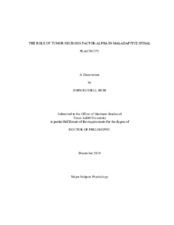| dc.description.abstract | Previous work has shown that the spinal cord is capable of supporting a simple
form of instrumental learning. Subjects that receive controllable shock to an extended
hind limb will increase the duration of limb flexion over time in order to reduce net
shock exposure. Exposure to as little as 6 minutes of uncontrollable stimulation prior to
instrumental testing can elicit a long-lasting learning deficit. Prior work has suggested
that this deficit may reflect an overexcitation of spinal neurons akin to central
sensitization, and that learning is inhibited by the saturation of plasticity. The
experiments in this dissertation were designed to test the role of the cytokine tumor
necrosis factor alpha (TNFa) in the induction and expression of the deficit. It is believed
that the inflammatory properties of TNFa may mediate the excitatory processes that lead
to maladaptive spinal functioning.
Experiments 1 and 2 tested the necessity of endogenous TNFa in the deficit
produced by uncontrollable shock. These experiments showed that the inhibition of
endogenous TNFa blocks both the induction and expression of the shock-induced
deficit, suggesting a necessary role for TNFa in mediating the inhibition of spinal
learning. Conversely, Experiment 3 was designed to test the sufficiency for TNFa in producing a learning deficit. I found that treatment with exogenous TNFa undermined
spinal learning in a dose-dependent fashion, whether given immediately, or 24 hours
prior to testing. Experiment 4 demonstrated that the long-term TNFa-induced deficit is
mediated by TNFa receptor activity, as a TNF inhibitor given prior to testing blocked
the expression of this deficit.
As TNFa has been shown to be predominantly of glial origin, I next assessed the
role that glia play in the TNFa-induced deficit. Experiment 5 showed that inhibiting
glial metabolism prior to TNFa treatment blocked the capacity for TNFa to produce a
long-term deficit. Experiment 6 assessed the potential for TNFa inhibition to block the
deficit induced by lipopolysaccharide (LPS), an agent known to induce TNFa. TNFa
has also been shown to drive neural excitation by increasing the trafficking of calciumpermeable
AMPA receptors to the active zone of the post-synaptic bouton. Experiment 7
showed that selectively antagonizing these receptors prior to testing blocked the TNFa-
induced deficit, suggesting a possible post-synaptic mechanism by which TNFa exerts
its effects.
Finally, histological evidence was sought to reinforce the previous behavioral
findings. Experiment 8 used quantitative RT-PCR to assess the differential expression of
TNFa mRNA in uncontrollably shocked subjects as compared to those receiving
controllable shock and no shock. To determine concentrations of TNFa protein, an
ELISA was run in Experiment 9 comparing uncontrollably shocked subjects to
unshocked controls. | en |


